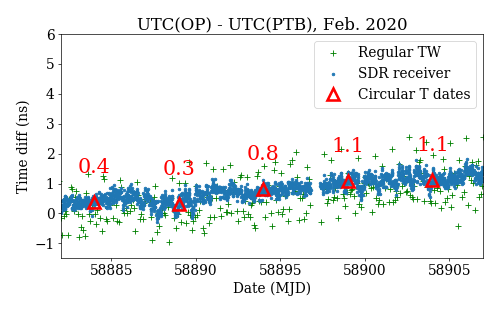
Two-Way Satellite Time and Frequency Transfer: first use of a Software Defined Radio receiver in UTC calculation
Two-Way Satellite Time and Frequency Transfer, improved by the Software-Defined Radio (SDR) receiver, has been used for Circular T calculation for the first time in March 2020. The comparison between the French and German local realizations of UTC, UTC(OP) and UTC(PTB), was performed using SDR receivers, a method that replaces part of the time-transfer hardware with high-speed digitization and software data processing. This significantly improves the 1-day stability of the time comparison.
Development of this particular SDR receiver has been realized by teams from TL (Telecommunication Laboratories (Chinese Taipei)), LNE-Syrte - Observatoire de Paris (France) and several NMIs within the framework of a Pilot Project launched in 2016 by the CCTF Working Group on TWSTFT. This Working Group had the aim of characterizing the performance of the receiving SDR chain, its long-term stability, the possibility of calibration, and of stable and reliable operation in the long term. The first calibration of such a link has been realized between LNE-Syrte - Observatoire de Paris and the PTB (Germany), paving the way for its inclusion in the Circular T calculation. The BIPM Time Department provided support to the development of this new technique, monitored its results, and assessed its long-term usability for UTC calculation over the last few years.
